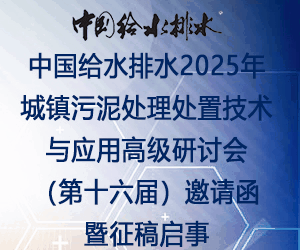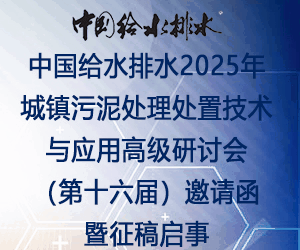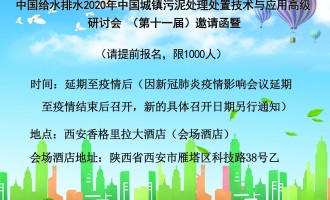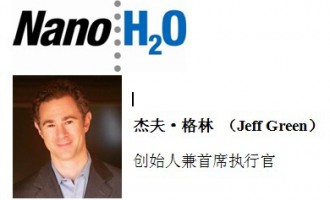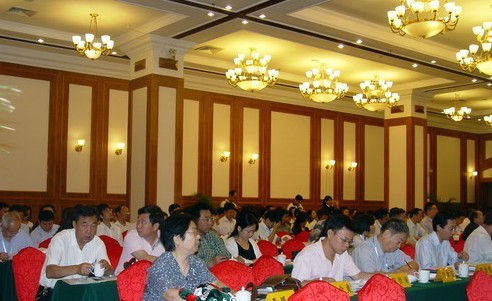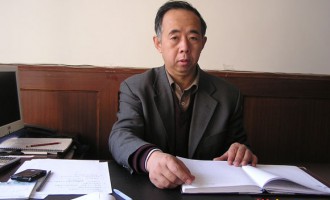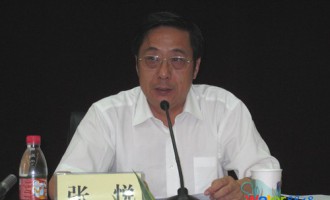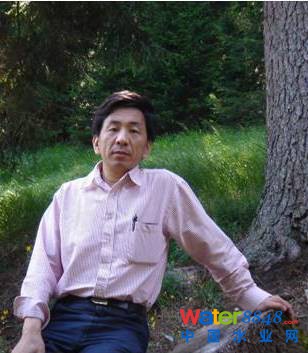 |
倪晋仁 |
|||||||
|
||||||||
 |
|
|||||||
|
|
主持的代表性项目:
l 国家优秀中青年人才专项基金“泥石流的结构两相流模型”(59421004, 1995-1997 )
l 国家杰出青年基金项目“高浓度固液两相流和风沙运动理论研究”(49625101, 1997-2001)
l 国家自然科学基金重大项目“江河泥沙形成机理及其防治研究”(59890200, 1997-2002)
l 国家重点基础研究规划项目课题“黄河断流对河流系统生态环境功能的影响”(G1999043603, 1999-2004)
l 国家重点基础研究规划项目课题“流域产沙机制与水沙运移规律研究”(2007CB407202, 2007-2011)
l 欧盟科技项目“可持续的水环境管理策略研究”(INCO-DC-ERBIC18CT960128, 1997-2000)
l 加拿大CIDA科技合作项目“防洪、生态保护和可持续发展研究”(UPCD-Tier2-Project 098/S47074-296,项目中方负责人, 1999-2005)
l 中国-欧盟环境管理合作项目(EMCP)课题“水资源管理机制建设与河流生态修复研究”(ALA/CHN/96/6, 2004-2005)
l 国家科技支撑计划课题“南水北调中线工程丹江口水源区黄姜加工新工艺关键技术研究”(2006BAB04A14, 2006-2010)
l 国家水体污染控制与治理科技重大专项课题“湘江水环境重金属污染整治关键技术研究与综合示范”(2008ZX07212-001, 2009-2012)
l 国家水体污染控制与治理科技重大专项项目“特殊类型河流污染防治与水质改善关键技术研究与示范”(2008ZX07212, 2009-2012)
l 国家自然科学基金委员会(NSFC)与日本科学技术振兴机构(JST)重大国际合作研究项目“焦化废水中高氨氮难降解有机物去除的生物强化机理研究”(21261140336/B070302, 2009-2012)
|
|
|
部分国际杂志论文(通讯作者或第一作者):
水处理理论与技术(*为通讯作者)
l Hongna Li, Jinren Ni*, Electrogeneration of disinfection byproducts at a boron-doped diamond anode with resorcinol as a model substance, Electrochimica Acta, 2012, 69: 268-274.
l Xiuping Zhu, Jinren Ni*, Xuan Xing, Hongnan Li, Yi Jiang, Synergies between electrochemical oxidation and activated carbon adsorption in three-dimensional boron-doped diamond anode system, Electrochimica Acta, 2011, 56(3): 1270-1274.
l Xiuping Zhu, Jinren NI*, Scale-up of B-doped diamond anode system for electrochemical oxidation of phenol simulated wastewater in batch mode,Electrochimica Acta, 2011, 56(25): 9439-9447.
l Xiuping Zhu, Jinren Ni*, The improvement of boron-doped diamond anode system in electrochemical degradation of p-nitrophenol by zero-valent iron,Electrochimica Acta, 2011, 56(28): 10371-10377.
l Xuan Xing, Xiuping Zhu, Hongna Li, Jinren Ni*, Electrochemical oxidation of nitrogen-heterocyclic compounds at boron-doped diamond electrode,Chemosphere, 2012, 86: 368-375.
l Xiuping Zhu, Jinren Ni*, Junjun Wei, Xuan Xing, Hongna Li, Yi Jiang, Destination of organic pollutants during electrochemical oxidation of biologically-pretreated dye wastewater using boron-doped diamond anode, Journal of Hazardous Materials, 2011, 189(1-2): 127-133.
l Hongna Li, Xiuping Zhu, Jinren Ni*, Comparison of electrochemical method with ozonation, chlorination and monochloramination in drinking water disinfection, Electrochimica Acta, 2011, 56(27): 9789-9796.
l Lin Xiong, Cheng Chen, Qing Chen, Jinren Ni*, Adsorption of Pb(II) and Cd(II) from aqueous solutions using titanate nanotubes prepared via hydrothermal method, Journal of Hazardous Materials, 2011, 189(3): 741-748.
l Lin Xiong, Weiling Sun, Ye Yang, Cheng Chen, Jinren Ni*, Heterogeneous photocatalysis of methylene blue over titanate nanotubes: Effect of adsorption,Journal of Colloid and Interface Science, 2011, 356(1): 211-216.
l Junjun Wei, Xiuping Zhu, Jinren Ni*, Electrochemical oxidation of phenol at boron-doped diamond electrode in pulse current mode, Electrochimica Acta, 2011, 56(15): 5310-5315.
l Xiuping Zhu, Jinren Ni*, Wei Junju, Scale-up of BDD anode system for electrochemical oxidation of phenol simulated wastewater in continuous mode,Journal of Hazardous Materials, 2010, 184(1-3): 493-498.
l Hongna Li, Xiuping Zhu, Jinren Ni*, Inactivation of Escherichia coli in Na(2)SO(4) electrolyte using boron-doped diamond anode, Electrochimica Acta, 2011, 56(1): 448-453.
l Xiuping Zhu, Jinren Ni*, Hongna Li, Yi Jiang, Xuan Xing, Effects of ultrasound on electrochemical oxidation mechanisms of p-substituted phenols at BDD and PbO2 anodes, Electrochimica Acta, 2010, 55(20): 5569-5575.
l Jiang Yi, Xiuping Zhu, Hongna Li, Jinren Ni*, Effect of Nitro Substituent on Electrochemical Oxidation of Phenols at Boron-doped Diamond Anodes,Chemosphere, 2010, 78(9): 1093-1099.
l Hongna Li, Xiuping Zhu, Yi Jiang, Jinren Ni*, Comparative electrochemical degradation of phthalic acid esters using boron-doped diamond and Pt anodes,Chemosphere, 2010, 80(8): 845-851.
l Bin Zhao, Huazhang Zhao, Jinren NI*, Arsenate removal by Donnan Dialysis: Effects of the accompanying components, Separation and Purification Technology, 2010, 72(3): 250-255.
l Bin Zhao, Huazhang Zhao, Jinren NI*, Modeling of the Donnan dialysis process for arsenate removal, Chemical Engineering Journal, 2010, 160(1): 170-175.
l Lin Xiong, Ye Yang, Jiaxing Mai, Weiling Sun, Chaoying Zhang, Dapeng Wei, Qing Chen, Jinren Ni*, Adsorption behavior of methylene blue onto titanate nanotubes, Chemical Engineering Journal, 2010, 156(2): 313-320.
l Xiuping Zhu, Jinren NI*, Peng Lai, Advanced treatment of biologically pretreated coking wastewater by electrochemical oxidation using boron-doped diamond electrodes, Water Research, 2009, 43(17): 4347-4355.
l Xiuping Zhu, Jinren NI*, Simultaneous processes of electricity generation and p-nitrophenol degradation in a microbial fuel cell, Electrochemistry Communications, 2009, 11(2): 274-277.
l Lina Xu, Huazhang Zhao, Shaoyuan Shi, Guangzhi Zhang, Jinren Ni*, Electrolytic treatment of Acid Orange 7 from aqueous solution by a three-dimensional electrode reactor, Dyes and Pigments, 2008, 77(1): 158-164.
l Jia-Xing Mai, Wei-Ling Sun, Lin Xiong, Ying Liu, Jin-Ren Ni*, Titanium dioxide mediated photocatalytic degradation of 17β-estradiol in aqueous solution,Chemosphere, 2008, 73(4): 600-606.
l Xiuping Zhu, Meiping Tong, Shaoyuan Shi, Huazhang Zhao, Jinren Ni*, An Essential Explanation to the Strong Mineralization Performance of Boron-doped Diamond Electrodes, Environmental Science and Technology, 2008, 42(13): 4914-4920.
l Xiuping Zhu, Shaoyuan Shi, Junjun Wei, Fanxiu Lv, Huazhang Zhao, Jiangtao Kong, Qi He, Jinren NI*, Electrochemical oxidation characteristics of p-Substituted phenols using boron-doped diamond electrode, Environmental Science and Technology, 2007, 41 (18): 6541-6546.
l Jun Zhu, Huazhang Zhao, Jinren Ni*, Fluoride distribution in electrocoagulation defluoridation process, Separation and Purification Technology, 2007, 56(2): 184-191.
l Jiangtao Kong, Shaoyuan Shi, Lingcai Kong, Xiuping Zhu, Jinren Ni*, Preparation and characterization of PbO2 electrodes doped with different rare earth oxides, Electrochimica Acta, 2007, 53(4): 2048-2054.
l Shuo Yao, Jinren Ni*, Qian Chen, Alistair G.L. Borthwick, Enrichment and characterization of a bacteria consortium capable of heterotrophic nitrification and aerobic denitrification at low temperature, Bioresource Technology, 2013, 127: 151-157.
l Qian Chen, Jinren Ni*, Ammonium removal by Agrobacterium sp LAD capable of heterotrophic denitrification, Journal of Bioscience and Bioengineering, 2012, 113 (5): 619-623.
l Qian Chen, Jinren Ni*, Heterotrophic nitrification-aerobic denitrification by novel isolated bacteria, Journal of Industrial Microbiology & Biotechnology, 2011, 38(9): 1305-1310.
l Hui Li, Jinren Ni*, Treatment of wastewater from Dioscorea zingiberensis tubers used for producing steroid hormones in a microbial fuel cell, Bioresource Technology, 2011, 102(3): 2731–2735.
l Jia Cheng, Xiuping Zhu, Jinren Ni*, Palm oil mill effluent treatment using a two-stage microbial fuel cells system integrated with immobilized biological aerated filters, Bioresource Technology, 2010, 101(8): 2729-2734.
l Yuling Zhu, Wen Huang, Jinren Ni*, Production of diosgenin from Dioscorea zingiberensis tubers through enzymatic saccharification and microbial transformation, Applied Microbiology and Biotechnology, 2010, 85(5): 1409-1416.
l Hui Li, Jinren Ni*, Wei Liu, Yuling Zhu, Cleaner production alternatives for saponin industry by recycling starch, Resources, Conservation and Recycling, 2010, 54(12): 1145–1151.
l Yuling Zhu, Wen Huang, Jinren Ni*, A promising clean process for production of diosgenin from Dioscorea zingiberensis C. H. Wright by Trichoderma reesei, Journal of Cleaner Production, 2010, 18(3): 242-247.
l Yuling Zhu, Jinren Ni*, Wen Huang, Process optimization for the production of diosgenin with Trichoderma reesei, Biopreocess and Biosystems Engineering, 2010, 33(5): 647-655.
l Peng Cheng, Huazhang Zhao, Jinren Ni*, Pilot treatment of wastewater from Dioscorea zingiberensis C.H. Wright production by anaerobic digestion combined with a biological aerated filter, Bioresource Technology, 2009, 100(12): 2918-2925.
l Baogang Zhang, Huazhang Zhao, Shungui Zhou, Chunhong Shi, Jinren Ni*, A novel UASB-MFC-BAF integrated system for high strength molasses wastewater treatment and bioelectricity generation, Bioresource Technology, 2009, 100(23): 5687-5693.
l Peng Lai, Huazhang Zhao, Ming Zeng, Jinren Ni*, Study on treatment of coking wastewater by biofilm reactors combined with zero-valent iron process,Journal of Hazardous materials, 2009, 162(2-3): 1423-1429.
l Lei Yao, Zheng-fang Ye, Mei-ping Tong, Peng Lai, Jin-ren Ni*, Removal of Cr3+ from aqueous solution by biosorption with aerobic granules, Journal of Hazardous Materials, 2009, 165(1-3): 250-255.
l Zhu Liang, Jinren Ni, Improving the ammonium ion uptake onto natural zeolite using an integrated modification process, Journal of Hazardous Materials, 2009, 166(1): 52-60.
l Li Fan, Jinren Ni*, Yanjun Wu, Yongyong Zhang, Treatment of bromoamine acid wastewater using combined process of micro-electrolysis and biological aerobic filter, Journal of Hazardous Materials, 2009, 162(2-3): 1204-1210.
l Li Fan, Shunni Zhu, Dongqi Liu, Jinren Ni*, Decolorization of 1-amino-4-bromoanthraquinone-2-sulfonic acid by a newly isolated strain of Sphingomonas herbicidovorans, International Biodeterioration & Biodegradation, 2009, 63(1): 88-92.
l Na Lu, Shun-gui Zhou, Jin-tao Zhang, Li Zhuang, Jin-ren Ni*, Electricity generation from starch processing wastewater using microbial fuel cell technology,Biochemical Engineering Journal, .2009, 43(3): 246-251.
l Dongkang Fu, Shaozu Wu, Xiaojia He, Jinren Ni*, Preparation and property analysis of polyacrylate dispersant for calcium carbonate,Colloids and Surfaces A: Physicochemical and Engineering Aspects, 2008, 326 (3): 122-128.
l Peng Lai, Huazhang Zhao, Zhengfang Ye, Jinren Ni*,Assessing the effectiveness of treating coking effluents using anaerobic and aerobic biofilms, Process Biochemistry, 2008, 43(3): 229-237.
l Na Lu, Shungui Zhou, Jinren Ni*, Mechanism of Energy Generation of Microbial Fuel Cell, Progress in Chemistry, 2008, 20(7/8): 1233-1240.
l Shuni Zhu and Jinren NI*, Treatment of Coking Wastewater by a UBF-BAF combined Process, Journal of Chemical Technology & Biotechnology, 2008, 83(3): 317-324.
l Shunni Zhu, Dongqi Liu, Li Fan, Jinren Ni*, Degradation of quinoline by Rhodococcus sp. QL2 isolated from activated sludge, Journal of Hazardous Materials, 2008, 160(2-3): 289-294.
l Li Fan, Shunni Zhu, Jinren Ni*, Decolorization mechanism of 1-amino-4-bromoanthraquinone-2-sulfonic acid using Sphingomonas herbicidovorans FL, Dyes and Pigments, 2008, 78(1): 34-38.
l Wen Huang, Huazhang Zhao, Jinren NI*, The best utilization of D. zingiberensis C.H. Wright by an eco-friendly process, Bioresource Technology, 2008, 99: 7407-7411.
l Peng Lai, Hua-zhang Zhao, Chao Wang, Jin-ren Ni*, Advanced treatment of coking wastewater by coagulation and zero-valent iron processes, Journal of Hazardous Materials, 2007, 147(1-2), 17: 232-239.
l Ming Chang, Shungui Zhou, Na Lu, Jinren Ni*, Enhanced Bacillus thuringiensis production from sewage sludge with alkaline and ultrasonic pretreatments,Water, Air & Soil Pollution, 2007, 186 (1-4): 75-84.
l Xin Zhao, Yanming Wang, Zhengfang Ye, Alistair G.L. Borthwick, Jinren Ni*, Oil Field Wastewater Treatment in Biological Aerated Filter by Immobilized Microorganisms, Process Biochemistry, 2006, 41: 1475-1483.
l Haidong Zhou, Jinren Ni*, Wen Huang, Jiandong Zhang. Separation of hyaluronic acid from fermentation broth by tangential flow microfiltration and ultrafiltration, Separation and Purification Technology, 2006, 52 (1): 29-38.
l Jinren Ni, Dingsheng Zhong, Yuefei Huang and Hao Wang, Total waste-load control and allocation based on input-output analysis for Shenzhen, South China, Journal of Environmental Management, 2001, 61: 37-49.
水沙运动与效应
l Jinren Ni*, Yao Yue, Alistair G.L. Borthwick, Tianhong Li , Chiyuan Miao , Erosion-induced CO2 flux of small watersheds, Global and Planetary Change, 2012, 94-95: 101–110.
l Yao Yue, Jinren Ni*, Alistair G. L. Borthwick and Chiyuan Miao, Diagnosis of river basins as CO2 sources or sinks subject to sediment movement, Earth Surface and Process Landforms, 2012, 37(13): 1398-1406.2012.
l Jinren Ni*, Jinshui Sun, Alistair G.L. Borthwick, and Yuan Fang, Rapid assessment of intertidal wetland sediments, Soil and Sediment Contamination, 2012, 21(5): 574-585.
l Zhang, Guangzhi; Sun, Weiling; Hu, Hao; Ni, Jinren*, Sorption of phenanthrene on to soil fractions in the presence of Triton X-100, Environmental Technology, 2012, 33(3): 321-327.
l Chiyuan Miao, Jinren Ni*, Alistair GL Borthwick, A preliminary estimate of human and natural contributions to the changes in water discharge and sediment load in the Yellow River, Global and Planetary Change, 2011, 76(3-4): 196-205.
l Peng Han, Jinren Ni*, Kebin Hou, Chiyuan Miao, Tianhong Li, Numerical modeling of gravitational erosion in rill systems, International Journal of Sediment Research, 2011, 26(4): 403-415.
l Jinren Ni*, Liying Sun, Tianhong Li, Xheng Huang, Assessment of flooding impacts in terms of sustainability in mainland China. Journal of Environmental Management, 2010, 91(10): 1930-1942.
l Chiyuan Miao, Jinren Ni*, Alistair GL Borthwick, Recent changes of water discharge and sediment load in the Yellow River basin, China, Progress in Physical Geography, 2010, 34(4): 541-561.
l Liying Sun, Jinren Ni*, Alistair GL Borthwick. Rapid Assessment of Sustainability in Mainland China. Journal of Environmental Management, 2010,91(4): 1021-1031.
l Mei Han, Guodong Ji, Jinren Ni*, Washing of field weathered crude oil contaminated soil with an environmentally compatible surfactant, alkyl polyglucoside, Chemosphere, .2009, 76(5): 579-586.
l Dajun Feng, Zhenshan Li, Jinren NI*, Sidewall effects of wind tunnel on aeolian sediment saltation, Geomorphology, .2009, 106(3-4): 253-260.
l Dajun Feng, Zhenshan Li, Jinren NI*, Launch velocity characteristics of non-uniform sand in aeolian saltation, Physica A: Statistical Mechanics and its Applications, 2009, 388(8): 1367-1374.
l Liying Sun, Weiling Sun, Jinren Ni*, Partitioning of water soluble organic carbon in three sediment size fractions: Effect of the humic substances, Journal of Environmental Sciences, 2009, 21(1): 113-119.
l Guangzhi Zhang, Hao Hu, Weiling Sun, Jinren Ni*, Sorption of Triton X-100 on soil organic matter fractions: kinetics and isotherms, Journal of Environmental Sciences, 2009, 21(6): 795-800.
l Chiyuan Miao, Jinren Ni*, Variation of Natural Streamflow since 1470 in the Middle Yellow River, China, International Journal of Environmental Research and Public Health, 2009, 6(11): 2849-2864.
l Jinren Ni*, Xiuxia Li, Alistair GL Borthwick, Soil erosion assessment based on minimum polygons in the Yellow River basin, Geomorphology, 2008, 93(3-4): 233-252.
l Lei Yao, Zhengfang Ye, Zhongyou Wang, Jinren NI*, Characteristics of Pb2+ biosorption by aerobic granular biomass, Chinese Science Bulletin, 2008, 53(6), 948-953.
l Zhenshan Li, Dajun Feng, Shiliang Wu, Alistair GL Borthwick, Jinren Ni*, Grain size and transport characteristics of non-uniform sand in aeolian saltation,Geomorphology, 2008, 100(3-4): 484-493.
l Nan Xu, Jinren Ni*, and Weiling Sun, Effects of Copper on the Sorption of Phthalate Esters to the Yellow River Sediment, Water, Air and Soil Pollution, 2007, 184(1-4): 207-216.
l Nan Xu and Jinren Ni*, Role of Dissolved Organic Carbon in the Co-sorption of Copper and Phthalate Esters onto Yellow River Sediments, Chemosphere,2007, 69: 1419-1427.
l Jinren Ni*, Liyiing Sun, Weiling Sun, Modification of chemical oxygen demand monitoring in the Yellow River with a high content of sediments, Water Environment Research, 2007, 79 (11): 2336-2342.
l Jinren Ni*, Renzhi Liu, Onyx WH Wai, Alistair GL Borthwick, Xiaodong Ge, Rapid zonation of abrupt mass movement hazard, Part I: General principles,Geomorphology, 2006, 80 (3-4): 214-225.
l Renzhi Liu, Jinren Ni*, Alistair GL Borthwick, zhenshan Li, Onyx WH Wai, Rapid zonation of abrupt mass movement hazard, Part II: Applications,Geomorphology, 2006, 80 (3-4): 226-235.
l Jinren Ni* and Peng Han, Grain size variation in the Middle Yellow River subject to soil conservation, Journal of Water and Soil Conservation, 2005, 60(2):99-110.
l Jinren Ni*, Zhenshan Li and Cesar Mendoza, Blown-sand transport rate, Earth Surface Processes and Landforms, 2004, 29(1): 1-14.
l Jianxin Xia, Jinren NI* and Cesar Mendoza, Hydraulic lifting of manganese nodules through a riser, Journal of Offshore Mechanics & Artic Engineering,ASME, 2004, 126(1):72-77.
l Zhenshan Li, Jinren Ni* and Cesar Mendoza, An analytic expression for wind-velocity profiles within the saltation layer, Geomorphology, 2004, 60:359-369.
l Jianxin Xia, Jinren NI* and Cesar Mendoza, Upward flow of large size particles-water mixtures through swaying pipes, Journal of Transportation Engineering, ASCE, 2004, 130(4): 535-543.
l Zhenghan Qian, Jinren Ni*, An Xue, Silke Wieprecht, Severity Level of No-flow Events in the Yellow River, Water International, 2004, 29(4): 432-438.
l Jinren Ni*, Hongwu Zhang, An Xue, Silke Wieprecht, Alistair GL Borthwick, Modeling of hyper-concentrated sediment-laden floods in Lower Yellow River, Journal of Hydraulic Engineering, ASCE, 2004, 130(10): 1025-1032.
l Jinren Ni*, Xiaoyong Liu, Tianhong Li, Ye’an Zhao, Ling Jin, Efficiency of Sediment Transport by Flood and Its Control in the Lower Yellow River,Science in China (Series E), 2004, 47(Supp.): 173-185.
l Jinren Ni*, Yudong Wang, Zhenghan Qian, Tianhong Li, Yean Zhao, On the Variation of Water Resource Structure in the Lower Yellow River, Science in China (Series E), 2004, 47(Supp.):127-141.
l Huaming Luo, Tianhong Li, Jinren Ni*, Yudong Wang, Water Demand for Ecological Protection in Rivers with Hyper-concentrated Sediment-laden Flow,Science in China (Series E), 2004, 47(Supp.):186-198.
l Jinren Ni*, Zhenshan Li and Cesar Mendoza, Vertical profiles of aeolian sand mass flux, Geomorphology, 2003, 49(3-4): 205-218.
l Jinren NI* and Jianxin Xia, Particle fluctuation intensities in sediment-laden flows, Mechanics Research Communications, 2003, 30: 25-32.
l Jinren Ni*, Honglian Wei and Guohe Huang, Environmental consequences of the Sanmenxia Hydropower Station Operation in Lower Yellow River, Energy Sources, 2003, 25(6): 519-546..
l Zhenshan Li and Jinren Ni*, Sampling efficiency of vertical array aeolian sand traps, Geomorphology, 2003, 52: 243-252.
l Jinren Ni*, Yingkui Li, Approach to soil erosion assessment in terms of land-use structure changes, Journal of Water and Soil Conservation, 2003, 58(3): 158-169.
l Jinren Ni* and An Xue, Application of artificial neural network to ecological risk assessment and rapid feedback in flood diversion zone, Engineering Applications of Artificial Intelligence, 2003, 16(2): 105-119.
l Jinren Ni* and Weiling Sun, Applicability of Langmuir equation to Copper sorption by loess with high Carbonate content, Hydrobiologia, 2003, .494(1-3):259-263.
l Nan Xu, Weiling Sun and Jinren Ni*, Chemical equilibrium modeling of Copper precipitation in hyper-concentrated solid-Liquid system, Hydrobiologia, 2003, 494(1-3): 201-206.
l Jinren Ni*, Xiangjiang Huang and Alistair GL Borthwick, Some characteristics of hyper-concentrated sediment-laden flows, Journal of Engineering Mechanics, ASCE, 2003, 129(12): 1489-1493.
l Jinren Ni*, Xiaojie Meng, Damage evaluation based on point-area integrated information in flood diversion basin, International Journal of Sediment Research, 2003, 18(2): 314-320.
l Jinren Ni*, Alistair GL Borthwick, and Huapeng Qin, Integrated approach to determining post-reclamation coastline, Journal of Environmental Engineering,ASCE, 2002, 128(6): 543-551.
l Huapeng Qin, Jinren Ni* and Alistair GL Borthwick, Harmonized optimal post-reclamation coastline for Deep Bay, China, Journal of Environmental Engineering, ASCE, 2002, 128(6): 552-561.
l Jinren Ni, Particle suspension in sediment-laden flow, Progress in Natural Science, 2002, 12(7): 481-492.
l Jinren Ni and Zhenghan Qian, Functional no-flow events in the Yellow River, Science in China (Series E), 2002, 45(5): 449-457.
l Lin Liang, Jinren Ni*, Alistair GL Borthwick, Simulation of dike-break processes in the Yellow River, Science in China (Series E), 2002, 45(6): 605-618.
l Jinren Ni and Xiaogang Meng, Forces on particles and their effects on vertical sediment sorting in solid-liquid two-phase flows, International Journal of Sediment Research, 2001, 16(2): 128-138.
l Jinren Ni and Huapeng Qin, Impact of river realignment and land reclamation on flood control and ecological habitat in river-estuary-bay system, Water International, 2001, 26(2): 206-214.
l Jinren Ni, Suiji Wang, Guangqian Wang, River patterns and spatial and temporal modes, International Journal of Sediment Research, 2000, 15(4): 357-370.
l Jinren Ni, Guangqian Wang and Alistair GL Borthwick, The kinetic theory for vertical profile of particle concentration in dilute and dense solid-liquid flows,Journal of Hydraulic Engineering, ASCE, 2000, 126(12): 893-903.
l Jinren Ni, Guangqian Wang and Qian Liao, A correction model for hyper-concentrated flow, Intern Journal Sediment Research, 1999, 14(2): 145-148.
l Guangqian Wang & Jinren Ni, Dynamic model of debris flows, Chinese Science Bulletin, 1994, 39(24): 2056-2062.
l Donghuo Zhou & Jinren Ni, Effects of dynamic interaction on sediment laden turbulent flows, Journal of Geophysical Research, 1995, 100: 981-996.
l Jinren Ni & Yujia Hui, Velocity concentration relation in sediment laden flow, International Journal of Sediment Research, 1993, 8(2): 85-99.
l Jinren Ni & Guangqian Wang, Closure to “Vertical sediment distribution”, Journal of Hydraulic Engineering, ASCE, 1992, 118(10): 1460-1461.
l Jinren Ni & Guangqian Wang, Vertical sediment distribution, Journal of Hydraulic Engineering, ASCE, 1991, 117(9): 1181-1194.
l Guangqian Wang & Jinren Ni, The kinetic theory for dilute solid/liquid two-phase flows, International Journal of Multi-Phase flow, 1991, 17(2): 273-281.
l Jinren Ni & Guangqian Wang, On the two patterns of vertical distribution of suspended sediment concentration and their formation cause, International Journal of Sediment Research, 1991, 6(3): 55-72.
l Guangqian Wang & Jinren Ni, A kinetic theory for dilute particle concentration distribution, Journal of Engineering Mechanics, ASCE, 1990, 116(12): 2738-2748.
代表性中文论文:
l 倪晋仁、张仁, 河型成因的各种理论及其间关系, 地理学报, 1991年, 46卷3期, 366-372.
l 倪晋仁、王光谦, 泥石流的结构两相流模型: I. 地理学报, 1998年, 53卷1期, 66-76.
l 倪晋仁等, 泥石流的结构两相流模型: II. 地理学报, 1998年, 53卷1期, 77-86.
l 殷康前、倪晋仁, 湿地研究综述, 生态学报, 1998年, 18卷5期, 539-546.
l 倪晋仁、周东火, 低浓度固液两相流中泥沙垂线分布的摄动理论解, 水利学报, 1999年, 30卷5期, 1-5.
l 倪晋仁等, 低浓度固液两相流中泥沙对紊动水流结构的影响, 水利学报, 1999年, 30卷6期, 1-5.
l 倪晋仁、王随继, 论顺直河流, 水利学报, 2000年, 31卷12期, 14-20.
l 倪晋仁、梁林, 水沙流中的泥沙悬浮(I), 泥沙研究, 2000年第1期, 7-12.
l 倪晋仁、梁林, 水沙流中的泥沙悬浮(II), 泥沙研究, 2000年第1期, 13-19.
l 倪晋仁、王光谦, 高浓度恒定固液两相流运动机理探析:I.理论, 水利学报, 2000年, 31卷5期, 22-26.
l 倪晋仁、王光谦, 高浓度恒定固液两相流运动机理探析:II.应用, 水利学报, 2000年, 31卷5期, 27-32.
l 倪晋仁、廖谦, 阵性泥石流运动与堆积的欧拉-拉格朗日模型, 自然灾害学报, 2000年, 9卷3期, 8-14.
l 倪晋仁等, 多组分流元模型在稀性泥石流堆积分选特征研究中的应用, 水利学报, 2001年, 32卷2期, 16-23.
l 倪晋仁、方圆, 湿地泥沙环境动态评估方法及其应用研究, 环境科学学报, 2000年, 20卷6期, 665-669.
l 倪晋仁、李英奎, 基于土地利用结构变化的水土流失动态评估, 地理学报, 2001年, 56卷5 期, 611-621.
l 倪晋仁, 张剑, 基于自组织理论的黄土坡面细沟形成机理模型, 水利学报, 2001年, 32卷8期, 1-7.
l 倪晋仁, 韩鹏, 基于自组织理论的黄土坡面细沟发育特征分析, 水利学报, 2002年, 33卷第1期, 6-15.
l 倪晋仁、钱征寒, 论黄河功能性断流, 中国科学, 2002年, 32卷4期, 496-502.
l 倪晋仁等, 论河流生态环境需水, 水利学报, 2002 年, 33卷 9 期, 14-19.
l 倪晋仁等, 黄河下游河流最小生态环境需水量初步研究, 水利学报, 2002年, 33卷10期, 1-7.
l 倪晋仁、秦华鹏, 填海工程对潮间带湿地生境损失的影响评估, 环境科学与学报, 2003年, 23卷3期, 345-349.
l 倪晋仁, 论泥沙灾害学体系建立的理论基础, 应用基础与工程科学学报, 2003年, 11卷 1期, 1-9.
l 倪晋仁等, 泥沙灾害链及其在灾害过程规律研究中的应用, 自然灾害学报, 2004年, 13卷5期, 1-9.
l 倪晋仁、刘小勇, 黄河下游水资源转化结构及其变化规律, 中国科学(E辑), 2004年, 34卷 (增刊I), 103-116.
l 倪晋仁、王裕东, 黄河下游洪水输沙效率及其调控,中国科学(E辑), 2004年, 34卷 (增刊I), 144-154.
l 倪晋仁、刘元元, 论河流生态修复, 水利学报, 2006 年, 37卷9期, 1029-1037.
l 孔令裕、倪晋仁, 人工湿地去污模型的统一结构特征, 生态学报, 2007年, 27卷4期, 1-6.
l 倪晋仁、高晓薇, 河流综合分类及其生态特征分析:方法, 水利学报, 2011年, 42卷9期, 1009-1016.
l 倪晋仁、高晓薇, 河流综合分类及其生态特征分析:应用, 水利学报, 2011年, 42卷10期, 1177-1184.
|
|
|
l 倪晋仁、王光谦、张红武, 《固液两相流基本理论及其最新应用》, 科学出版社, 1991, 391.
l 倪晋仁、马霭乃, 《河流动力地貌学》, 北京大学出版社, 1998, 396.
l 倪晋仁、李振山, 《风沙两相流理论及其应用》, 科学出版社, 2006, 204.
l 倪晋仁、王兆印、王光谦等, 《江河泥沙灾害形成机理及其防治》, 科学出版社, 2008, 681.
l 倪晋仁、李天宏、毛小苓等(译),《四倍跃进》, 中华工商联合出版社,2001, 415.
l 周海林、倪晋仁(执行主编), 《城市河流生态修复手册》, 社会科学文献出版社, 2008, 273.
|
|
|
l 倪晋仁、叶正芳, 温丽丽, 垃圾渗滤液处理系统及方法, 专利号:ZL 2004 1 0074744.4
l 倪晋仁、朱秀萍, 一种用于深度处理垃圾渗滤液的方法, 专利号: ZL 201010222274.7
l 温丽丽、倪晋仁等, 一种中老龄垃圾渗滤液处理方法,专利号: ZL 200710119367.5
l 倪晋仁等, 从黄姜加工到废水处理一体化工艺, 专利号: ZL200610000162.0
l 倪晋仁等, 用催化溶剂法从黄姜提取皂素的生产工艺, 专利号: ZL 200910084842.9
l 朱秀萍、倪晋仁、程鹏, 一种黄姜废水的深度处理方法, 专利号: ZL 201010222283.6
l 倪晋仁、朱秀萍、魏俊俊, 一种用于处理苯酚废水的装置及其方法, 专利号: ZL 201010222308.2
l 朱秀萍、倪晋仁, 一种用于深度处理制药废水的方法, 专利号: ZL 201010222306.3
l 曾明、倪晋仁、叶正芳, 一种对高氨氮低C/N比的废水处理工艺及用途, 专利号: ZL 200710120657.1
l 倪晋仁、陈倩, 一步式去除废水中碳氮污染物的方法, PCT/CN2010/074604
l 倪晋仁、陈倩, 用于生物脱氮的木糖氧化无色杆菌菌株及其应用, 专利号: ZL 200910085187.9
l 倪晋仁、姚硕, 一种低温生物脱氮的约氏不动杆菌菌株及其应用, 专利号: ZL 201010543800.8
l 倪晋仁、仝国平、陈倩, 不同溶解氧条件下脱氮的铜绿假单胞菌菌株及其应用,专利号: ZL 2010191919.5
l 倪晋仁、朱婷婷, 一种可高效降解苯并[a]芘的不动杆菌及其应用, 专利号: ZL 201110047392.3
l 倪晋仁、朱婷婷, 一种可高效降解苯并[a]芘的短小芽孢杆菌及其应用, 专利号: ZL 201110047402.3
l 倪晋仁、姚磊, 培养好氧颗粒污泥的装置及其专用反应器, 专利号: ZL 200910088569.7
l 陈倩、倪晋仁, 具有异养硝化-好氧反硝化能力的土壤杆菌及其在含氮废水处理中的应用, 专利号: ZL 200910083014.3
l 倪晋仁、瞿利建、陈倩, 利用异养硝化-好氧反硝化细菌强化AB工艺脱氮的方法, 专利号: ZL 201110147010.4
|
|
l 环境科学与工程前沿 l 环境工程学科前沿研讨班
l 水沙环境研究
l 专业英语
若干学术观点
(1) 面向生态的水资源开发利用和管理是解决中国水问题的唯一出路。
主要观点(《人民日报》,2001年3月6日第十一版)
进入21世纪后,传统的工程型和资源型水资源开发利用和管理模式已不足以从根本上解决中国复杂的水问题,而且还可能会引起自然生态系统的严重退化。因而,必须在观念上进行转变,寻求能够解决中国水问题的根本出路。 面向生态的核心就是以最小的水资源投入获得最大的水生态服务, 即获得最大的自然-社会-经济综合生态效益。消耗的物质愈多,就意味着我们从自然生态系统索取的物质愈多,从而对生态系统可能造成的损害也就愈大。面向生态的水资源在某些方面可以在负成本的条件下得以实现,做到有利可图。面向生态的水资源开发利用和管理模式是提高水资源利用效率、治愈水资源浪费的良方。 面向生态,可以使水消耗和水污染更少,并使人们生活得更好。越是需要调水的地方,越需要面向生态。越是生态脆弱的地区,越需要面向生态。 面向生态,应该变水资源供需导向为水资源生产率提高导向,变单纯的分配定额制度为水资源的有偿转让制度,按照面向生态的市场机制利用水资源、出租水资源、回收水资源、转让水资源、管理水资源,使节水者获益。 在现有经济技术条件下,以不同地区的生态需求定开发利用的水资源量,以水定粮、以水定产、以水定草、以水定林、以水定发展。 我认为,面向生态的水资源开发利用是解决中国水问题的唯一出路。 上述观点于2001年3月4日在国家主席出席的全国政协九届四次会议民建、工商联界联组会上发言阐述, 后在人民日报、人民网、中国政协报报道或转载;在香山科学会议第158次学术讨论会“面向生态的水资源合理配置与调控”会议(2001年3月23-25日,倪晋仁、王浩、夏军任会议执行主席)上以“面向生态的水资源利用模式思考”为题报告,在中国科学基金上报道;全文详见“倪晋仁, 面向生态的水资源合理配置与调控, 《科学前沿与未来》(第六集, 香山科学会议主编),中国环境科学出版社, 2002年12月, 19-26”。 (2) 黄河不断流与功能性不断流的河流调控目标有着本质的不同。
主要观点(倪晋仁、钱征寒, 论黄河功能性断流, 中国科学, 2002年32卷4期, 496-502)
首次提出黄河功能性断流的概念,它本质上不同于通常意义的“零流量”断流,它是河道径流量不能满足河流基本功能最小需水量要求的特定事件,只有从功能上看待断流事件才能触及河流健康本质。 黄河断流系指河道水量减至为零的特殊现象, 只要尚存少许径流就不被认为断流; 黄河功能性断流着眼河流功能受损衰竭的临界状态, 即使河水仍未干枯也会被看作“断流”. 其次, 前者属于一种自然表象上的“绝对断流”, 后者则类似一种内在功能性的“相对断流”. 在河道径流明显减少直至小于某临界值时, 尽管黄河并未断流, 但是黄河功能性断流可能早已发生而且或许开始导致河流系统诸项(或某项)功能受损甚至暂时或永久地丧失. 黄河功能性断流属于一种不利于维护河流系统功能的事件, 它对各项功能的影响大小与断流发生的时空范围、频度和功能的易损性有着密切关系.黄河断流的影响不仅表现为河流功能受损的严重程度, 而且取决于受损河流功能的恢复能力. 黄河断流后需要恢复的是流量不为零的表象景观, 而黄河功能性断流后需要恢复的则是健康河流的实际功能, 应该从近期和远期综合考虑, 将现状与后效优化协调.黄河断流的现象必然会引出黄河功能性断流的问题. 黄河表象不断流与功能性不断流的河流调控目标有着本质的不同。 上述观点于1997年10月31日~11月2日在中国科协举办的第27次“青年科学家论坛”港、澳、台、大陆“环境-水利-地理-泥沙交叉科学前沿问题”讨论会(倪晋仁、王光谦、李行伟任执行主席)上报告,在《科技导报》1998年第4期上发布了青年科学家关于及时开展“黄河断流问题研究”的建议;后在973课题支持下发表系列论文;目前,黄河等多条河流已将“从河流不断流到河流功能性不断流”作为河流健康维护的基本原则和努力目标。 (3) 泥沙灾害理论体系的建立是解决新时期江河水沙灾害问题的基础。
主要观点(倪晋仁, 论泥沙灾害学体系建立的理论基础, 应用基础与工程科学学报, 11 卷 1 期, 2003年, 1-9;倪晋仁、王兆印、王光谦,江河泥沙灾害形成机理及其防治研究,中国科学基金,1999年第5期,287-284)
提出了泥沙灾害、泥沙圈的概念和泥沙灾害学学科体系建立的框架。 泥沙灾害学是泥沙学、地貌学与灾害学学科交叉的产物, 它是描述泥沙在其侵蚀、输移和沉积运动发生变异时造成灾祸过程及其防治方法的科学。泥沙灾害既具有类似于其它灾害的一般特性, 又具有自身的特性和规律。 泥沙灾害具有链锁式反应机制, 在一定条件下构成泥沙灾害链。泥沙灾害的渐发特征和强次生灾害特征、时间积累效应和异地传输效应研究,是认识流域泥沙灾害过程规律和制定防治战略的重要基础。 作为相对独立于过去四大灾害的系统, 明确的运动物质主体、固有的颗粒运动特性、独特的泥沙灾害系统和不同的灾害防治方法形成了泥沙灾害学的特殊体系。 20世纪90年代以来,泥沙运动已成为近年来加剧江河洪灾引发“小水大灾”的根本原因之一,迫切需要从深层次揭示泥沙灾害形成规律和防治方法。鉴于此,1997年国家自然科学基金委员会与水利部联合设立自然科学基金重大项目“江河泥沙灾害形成机理及其防治研究”(项目主持人为倪晋仁、王兆印、王光谦),开展了历时5年的系统研究。项目完成后获得“特优”评价,成果集中反映在100多万字的专著《江河泥沙灾害形成机理及其防治研究》中,主要成果获得2010年国家科技进步二等奖。 (4) 受损河流生态修复的关键是其系统功能的恢复。
主要观点:(详见代表性中文论文:论河流生态环境需水,黄河下游河流最小生态环境需水量初步研究,论河流生态修复, 湿地研究综述等 4 篇相关中文论文被 CNKI《中国引文数据库》他引约 800次)
输沙功能是多沙河流要求满足的一项重要系统功能,研究多沙河流的生态环境需水必须考虑河流的输沙用水。一般确定河流生态环境需水量的计算方法,因其很少考虑多沙河流的生态环境需水特点而往往只适用于少沙河流。黄河生态环境需水中输沙用水需求远高于其他功能用水需求, 输沙需水占生态环境需水的绝大部分。 黄河下游汛期最小生态环境需水量主要由输沙用水的需求决定,当汛期输沙需水得到满足时, 不仅可以输送全年的大部分泥沙, 而且河流其他功能用水需求可以自动得到满足, 此时的生态环境需水量与输沙需水量相当。 在非汛期,高村、艾山、利津三部对应的各种功能所需临界流量也以输沙需水量为最大,但因该阶段各个河段输沙效率较低,可以优先考虑河流污染防治功能与河流生态功能,取其所需临界流量中较大的一个作为河流生态环境需水量。 非汛期输沙需水得到满足时,同样可以满足河流其他功能的用水需求, 但因输沙效率较低而导致相应的水资源浪费。根据多沙河流生态环境需水的特点, 可利用水利枢纽进行适当的水沙组合调控,将非汛期来沙集中在汛期输送, 从而达到减轻河道淤积,降低生态环境需水量,提高水资源利用效率的目的。 根据水资源在河流系统中的不同服务目标, 将黄河下游各主要水文断面的水资源划分为生态环境水、资源水和灾害水3个组成部分(简称“三水”), 并给出了50多年来“三水”的相互转化情况及其变化规律。 以提高洪水输沙用水效率为目标, 采用开环控制和反馈控制对洪水输沙过程调控进行了模拟与仿真,指出当黄河下游花园口以下河段含沙量小于20kg/m3时, 流量对输沙用水量减小有很好的调控作用;含沙量为20 kg/m3时, 适宜的调控流量范围是2390~2900 m3/s。 以河流系统诸功能与河流健康之间的关系为主线,从人与河流关系的发展与变化出发,深入探讨了原始自然阶段、工程控制阶段、污染治理阶段和河流生态系统修复和改善等四个阶段的河流特点和治理条件,分析了各个阶段河流系统平衡的特征和影响因素,建立了河流健康诊断指标体系,提出了河流生态修复的主要原则。河流生态修复的总体目标是恢复河流系统健康,实现人与河流的和谐共存。明确河流健康、河流功能、功能要素和生态修复措施四个层次的关系是实现河流生态修复基础。 |


